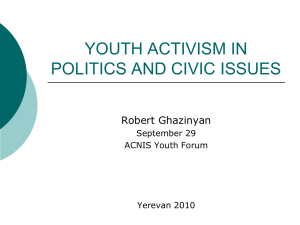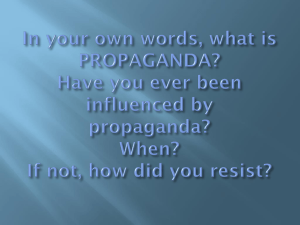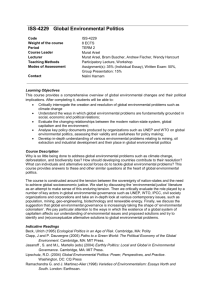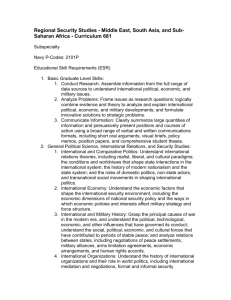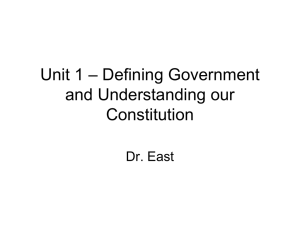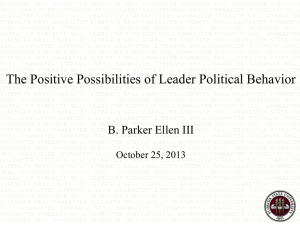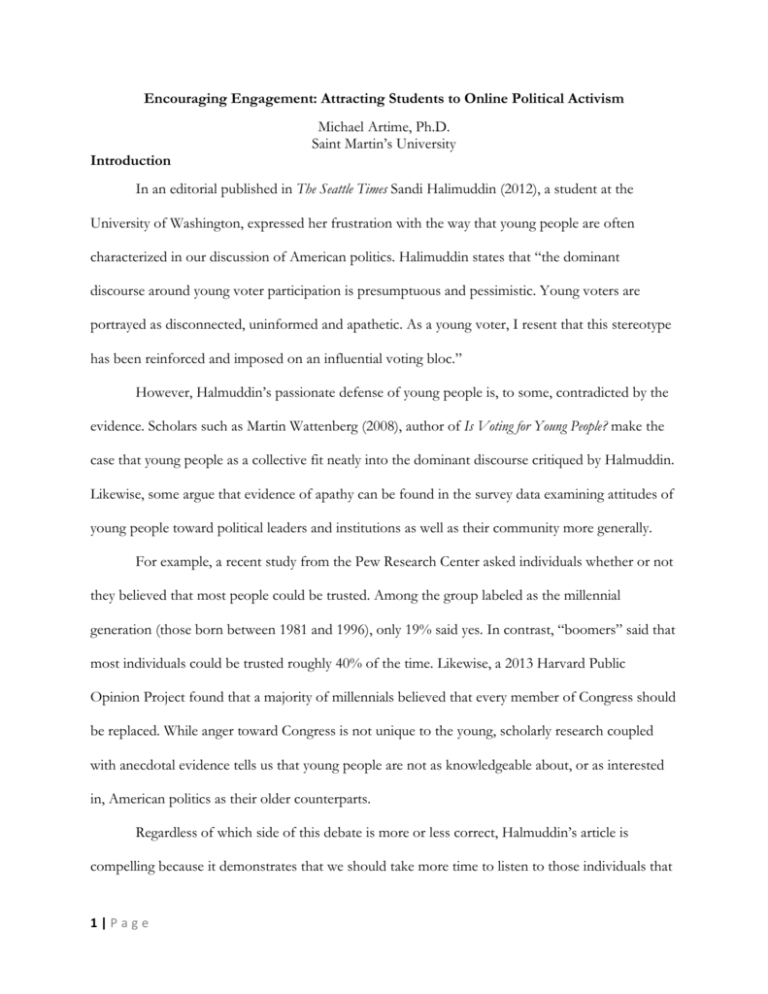
Encouraging Engagement: Attracting Students to Online Political Activism
Introduction
Michael Artime, Ph.D.
Saint Martin’s University
In an editorial published in The Seattle Times Sandi Halimuddin (2012), a student at the
University of Washington, expressed her frustration with the way that young people are often
characterized in our discussion of American politics. Halimuddin states that “the dominant
discourse around young voter participation is presumptuous and pessimistic. Young voters are
portrayed as disconnected, uninformed and apathetic. As a young voter, I resent that this stereotype
has been reinforced and imposed on an influential voting bloc.”
However, Halmuddin’s passionate defense of young people is, to some, contradicted by the
evidence. Scholars such as Martin Wattenberg (2008), author of Is Voting for Young People? make the
case that young people as a collective fit neatly into the dominant discourse critiqued by Halmuddin.
Likewise, some argue that evidence of apathy can be found in the survey data examining attitudes of
young people toward political leaders and institutions as well as their community more generally.
For example, a recent study from the Pew Research Center asked individuals whether or not
they believed that most people could be trusted. Among the group labeled as the millennial
generation (those born between 1981 and 1996), only 19% said yes. In contrast, “boomers” said that
most individuals could be trusted roughly 40% of the time. Likewise, a 2013 Harvard Public
Opinion Project found that a majority of millennials believed that every member of Congress should
be replaced. While anger toward Congress is not unique to the young, scholarly research coupled
with anecdotal evidence tells us that young people are not as knowledgeable about, or as interested
in, American politics as their older counterparts.
Regardless of which side of this debate is more or less correct, Halmuddin’s article is
compelling because it demonstrates that we should take more time to listen to those individuals that
1|Page
we often reduce to numbers in a dataset. This paper is an attempt to provide a voice to students
such as Halmuddin who feel that they may be unfairly characterized by research, the media, their
older counterparts, and even amongst those in their own age cohort. This paper will analyze the
results of four focus groups on the campus of a small liberal arts university in Washington. While it
is not possible to generalize these results to a larger population, there is something uniquely
important about taking steps to provide avenues through which young people can share their
thoughts, experiences, and challenges.
The focus group will attempt to address three fundamental questions:
1. How do young people think of the current state of American politics?
2. How involved are young people in the political process?
3. In what ways have new media technologies changed, or failed to change, the way that young people engage
in the political process?
Without becoming too Pollyannaish, young people represent the future of American politics
and it is important that we consider whether or not the current political environment is adequately
preparing them for this task.
Literature Review
Robert Putnam’s (2000) Bowling Alone sparked a great deal of scholarly debate concerning
civic engagement and the connection, or lack thereof, that people have with their community.
Putnam contends that, unlike generations in the past, young people are not particularly interested or
involved in politics. Martin Wattenberg (2008) also argues that young people are virtually
inconsequential in American politics due to their relative lack of interest and knowledge. Others,
such as Russell Dalton (2008) in his text The Good Citizen posit that the problem is not the lack of
involvement on the part of young people, but rather it is with the measures that we use to measure
said involvement. Dalton argues that young people are not particularly interested in duty-based
forms of civic participation (i.e. voting) but are much more interested than their older counterparts
in engaged forms of citizenship (i.e. protesting, advancing tolerant political attitudes). Despite their
2|Page
differences, followers of Putnam and of Dalton would both agree that interest in and engagement
with one’s community is a virtue that ought to be fostered.
Head (2011, 541) articulately discusses why addressing the lack of youth involvement is
something that deserves our attention. He states:
First, is the argument that young people have the right to be nurtured, protected
and treated with respect, and where appropriate be involved and consulted.
Secondly, it is argued that improvement of services for young people requires their
views and interests to be well articulated and represented. Thirdly, it is asserted that
there are developmental benefits arising from participation, for both the individuals
themselves and for civil society as a whole.
The advent of new technology, for some, represents a monumental breakthrough in the
development of techniques to attract young people to civic engagement. Boulianne (2009) in a metaanalysis concludes that Internet use is related to increased civic engagement. However, she cautions
that the effect of this relationship is rather small. Likewise, Wicks et al (2014) through a national
mail survey distributed in October 2012 found that those who were political engaged in advance of
the 2012 presidential election also appeared to have a strong interest in online media usage.
However, some research has suggested that those using the Internet and new media to
engage in American politics are essentially the same individuals who engage in offline forms of
activism. In other words, the Internet does not foster new interest in politics but simply offers a new
tool to those who are already engaged (Vitak and Zube 2011; Carlisle and Patton 2013; Rainie,
Purcell, and Smith 2011; Oser, Hooghe, and Marien 2013). Bennett et al (2011) posits that the failure
of online movements can be attributed to the fact that those running these online sites tend to try to
translate their offline movements into the new online environment. They argue that this misses that
fundamental point that young people are not attracted to traditional political movements—whether
or not they originate online or offline. Lupia and Philpot (2005, 1138) caution that it is unhelpful to
think of the Internet in the aggregate. They posit that “if the web is going to affect people’s political
3|Page
interest it is going to be because a particular site catches their attention and induces them to think
about some aspect of politics in ways that they had not before.”
Even if online movements successful attract young people to various forms of political
engagement, it is often argued that online activity is a poor substitute for online efforts. Evgeny
Morozov (2011), for example, argues that “slacktivism” would be the more appropriate terminology
to use when describing online political activity. He states that this form of involvement is “premised
on the assumption that, given enough tweets, the world’s problems are solveable; in the language of
computer geeks, given enough eyeballs, all bugs are shallow” (190).
This paper is an attempt to give a voice to those young people at the heart of this discussion.
If we assume that American politics is better when young people are involved, interested, and
considered then it is necessary for us to start a dialogue that allows us to better understand the
conditions under which those trends are most likely to occur.
Research Design
This paper relies on data gathered through a series of four focus groups on the campus of
Saint Martin’s University, a small Benedictine liberal arts institution in Lacey, Washington. Students
were recruited through an email sent to all undergraduate students, encouraging them to meet with
me and a few other students for approximately 45 minutes to discuss the role of the Internet in
American politics. In exchange for their participation students were offered light snacks and, in
some cases, extra-credit from their professor. The focus groups took place between March 16 and
March 23, 2015.
Before beginning the focus group students were asked to complete a brief questionnaire
containing some basic demographic information including their age, race, year in school, and party
identification. In total, 15 students agreed to participate in the study. For the purposes of this study,
I will only include the results from students 30 years of age or under. Consequently, only 10 of the
4|Page
15 students will be represented in this particular paper. Of these 10 students, 7 held junior status at
the university, 2 identified as seniors, and there was one sophomore. With regard to party
identification (using a 7-point scale from “strong Democrat” to “strong Republican”), 4 students
identified as moderate, 2 as a Weak Republican, 1 as a Democrat, 1 as a Republican, and 2 refused to
self-identify. In terms of political ideology (using a 7-point scale ranging from “extremely liberal” to
“extremely conservative”), 5 students identified as moderate, 1 as somewhat conservative, 1 as
conservative, 1 as liberal, and 2 refused to self-identify. With respect to race, 4 students identified as
white, 2 as Asian, 1 as black and 3 students did not identify their race. These focus groups were
predominately made up of women with 8 women and 2 men.
For most of the demographic variables, there was enough variance to say that individuals
with a diverse array of backgrounds and experience contributed to the results. However, it is
certainly not possible to say that the findings presented in this paper are generalizable to young
people or, for that matter, even to the student body at Saint Martin’s. However, the views depicted
in this paper are important in that they represent the real perspectives of these particular students.
As Head (2011) rightly pointed out, one of the reasons for encouraging civic engagement amongst
our youth is to ensure that their voices are listened to. This research was a small endeavor to do just
that.
Summary of Focus Groups
As part of the focus group students were asked to provide a description of what the term
“political activism” meant to them. While some students had less than positive views of activists
(using terms such as “extremists”) the majority felt that it was a way of advancing a particular idea.
For the purposes of this paper, we will focus on the involvement of young people in online political
movements. However, it is also necessary to continue to explore activism more generally.
5|Page
Consistent with the literature, these students held rather pessimistic views about the state of
American politics. Specifically, 6 of 10 students labeled their attitudes toward the future of American
politics as more pessimistic than optimistic. Students commented that their view of the future of
American politics was “horribly” and “hugely” pessimistic. Despite this generally negative
perspective of the American political system, a few students held out hope for change. One student
posited that, as a society, we are often impatient and want things to happen right away but it often
takes a great deal of time. She explains that “Even though change is not happening at the rate I
would like for it to happen I still believe it can.” Another student’s optimism comes from his
pessimistic view of the current political environment. He contends that “it cannot get any more
polarized.”
Likewise, students were asked to use one word to describe President Obama, the
Democratic Party, and the Republican Party. These are the words that the students selected:
President Obama: charismatic (used by two students), deceitful, celebrity, thinker, good man, nice,
bold, trying, lost
Democratic Party: influential, uninformed, liberal, polarized, equality, impractical, greener, petty
Republican Party: behind, detached, disorganized, oppression, volatile, country-bumpkin, petty
Interestingly, most students had something negative to say about each of the two major
parties. This is consistent with their evaluation of the state of the country—generally pessimistic. It
does appear as if several students were more supportive of President Obama than they were of
American politics as a whole. However, it is easy to see how descriptions such as “charismatic”
could be used to connote a positive or a negative evaluation on the part of the student.
When asked about their online political activity, most students rejected the idea that their
activity amounted to political activism. However, a few students claimed to be taking advantage of
this new forum. For example, one student cautiously said that what she was doing was “not
picketing” but it was a way to appeal to individuals. Likewise, another student posited that the online
6|Page
environment provided them a forum through which she can add her voice on an issue. Another
student with a background in the military argued that he found himself involved in online activity
with issues related to the military or 5th amendment concerns.
However, several students do not engage in online political activism and were asked what
barriers were preventing them from doing so. One student expressed social pressures caused her to
avoid political activism—a fear that her actions would end up hurting the feelings of those around
her. Another student simply claimed that she did not have the requisite “interest or passion” to
become politically active online or elsewhere. For those students who did not make use of the
Internet for political activism, there seemed to be a general malaise or apathy about the political
process.
Students were also asked to discuss the degree to which they engaged in specific forms of
online political activism. For example, several students claimed to have shared political news stories
through their social networking site. Of the 10 students, 5 of them claimed to have shared political
news stories with others through their social networking site. These students expressed a variety of
reasons for sharing these stories including: it “breaks up the monotony of silly things on the
Internet” and that sharing is a way to let others know when something “hits home and is exactly the
way that I feel.”
Likewise, students were asked about their use of the interactive tools available to them
online. Specifically, the ability to comment at the end of online news stories has introduced a lowcost means for individuals to express their thoughts on the biggest stories of the day. While some of
the students acknowledged finding helpful links or opinions in the comment sections of news
stories, they did not express personal experience or interest in posting themselves. Perhaps this was
a result of their less than positive attitudes toward those who post. Here are sampling of their
thoughts concerning those who write the comments at the end of news articles: “unreliable and
7|Page
almost uninformed,” “loud,” “they are hiding behind technology…[I] feel sorry for them that they
have to hide behind technology.”
In addition, students were asked whether or not they believed that online activism was as
effective as more traditional forms of activism (i.e. protesting). Several students believed that this
form of protest was as effective, or more effective, than more traditional activism. One student
expressed the belief that, if the issue was viewed as nationally important, online activism could
uniquely reach the necessary number of individuals to facilitate change. Another student concurred
positing that individuals are much more likely to see information if it is tweeted than they are if it is
simply presented at a protest. While students overwhelming believed that Internet activism had the
potential to motivate others, it seems as if there is at least some reticence amongst these students to
personally explore these new tools.
At the start of each focus group students were asked to write down the political news
sources they used on an average day. Of the 10 students, 4 stated that they did not have daily news
habits. Another student claimed to read very little. Consequently over half of the students opt not to
pay attention to politics. For those with daily news habits, they described the news sources that they
most frequently rely on as: “informative,” “opinion,” “shocking,” “convenient,” and “interesting.”
Students who do not use the news regularly posited that, in general, the media is “biased,” “messy,”
and “cursory…but sometimes detailed.” Intuitively, these results make sense and suggest that,
amongst this group, negative feelings about the media make it less likely that students will develop
daily news habits.
Students were also asked to make suggestions about one thing the news media could do
differently to improve the way that they cover American politics. Overwhelming, students felt that
the media should take efforts to minimize bias in coverage. Additionally, students argued that when
biased information was presented that it should be done so in a transparent way. The concerns
8|Page
expressed by these students are also reflected in the media and politics literature. For example, Prior
(2005) makes the case that the current state of political news allows individuals to select information
which appeals to their partisan interests. The consequence of allowing this type of selective attention
to the news is that individuals, according to Prior, have become more partisan over time.
Conclusion
Before positing several conclusions, it is important to note that there are many limitations
with regard to the analysis in this paper. First, the number of participants was very small and,
consequently, it is not possible to generalize the results to a larger population. Secondly, the findings
discussed in this paper are preliminary and a more robust content analysis is necessary to isolate
more concrete and specific trends. Finally, future variations of this research will include additional
measures of political engagement—both online and offline—so that a more complete picture can be
painted of youth participation.
There are several broad themes that can be isolated at the end of these focus groups. First,
the students were pessimistic concerning the current state of American politics, political leadership,
and the future. While skepticism is healthy and perhaps even a sign of engagement, eroding levels of
trust can lead to a lower impetus for getting involved politically. If we assume that political activism
is a necessary component of a strong democracy, then it is essential that the concerns of young
people are adequately addressed. These students expressed legitimate complaints about the current
political system, and the first step in addressing declining trust is to begin to take those complaints
seriously. Correspondingly, there is evidence that these students want to be listened to—this is
evident by the fact that they frequently share news stories that reflect their political attitudes with
others.
Secondly, for these students, the Internet does hold the potential for successful political
engagement. Students understand and believe in the power of a tweet to attract attention in a way
9|Page
that a traditional protest could not. However, they are also concerned with the dangerous rhetoric
that often characterizes online discourse. For these students this might suggest a sophisticated,
nuanced view of online tools. While they recognize the potential of new technology to advance
democratic politics they are also justifiably concerned about the voices that tend to overwhelm
online political debate.
The skepticism that these students had for politics and for the Internet was also reflected in
their attitudes toward the media. They believed that the media needed to focus less on entertainment
or presenting one side of a political debate, and more on trying to achieve greater transparency and
neutrality.
The literature suggests that there is a great deal of overlap between online activists and those
that pursue political activism offline. Perhaps this reflects an overarching skepticism which precludes
the engagement of young people in politics. Without first addressing some of these root concerns, it
is unlikely that any tool, no matter how new or innovative, will fundamentally solve the issue of
declining engagement and interest amongst our young citizens.
10 | P a g e
Bibliography
2014. Millennials in adulthood: Detached from institutions, networked with friends. Pew Research Center.
2015. Comparing Millennials to other generations. Pew Research Center.
Bennett, Lance W., Chris Wells, and Deen Freelon. 2011. Communicating civic engagement:
Contrasting models of youth citizenship in the youth web sphere. Journal of Communication 61:
835-856.
Boulianne, Shelley. 2009. Does Internet use affect engagement? A meta-analysis of research. Political
Communication 26 (2): 193-211.
Carlisle, Juliet E., and Robert C. Patton. 2013. Is social media changing how we understand political
engagement? An analysis of Facebook and the 2008 presidential election. Political Research
Quarterly 66 (4): 883-895.
Checkoway, Barry, and Adriana Aldana. 2013. Four forms of youth civic engagement for diverse
democracy. Children and Youth Services Review 35: 1894-1899.
Dalton, Russell J. 2008. The good citizen: How a younger generation is shaping American politics. Washington,
D.C.: CQ Press.
Halimuddin. 2012. “Young voters are not apathetic. In The Seattle Times.
Head, Brian W. 2011. Why not ask them? Mapping and promoting youth participation. Children and
Youth Services Review 33: 541-547.
Kohnle, Ian. 2013. “Angry, yet apathetic: The young American voter.” In Harvard Political Review.
Lenzi, Michela, Alessio Vieno, Massimiliano Pastore, and Massimo Santinello. 2013. Neighborhood
social connectedness and adolescent civic engagement: An integrative model. Journal of
Environmental Psychology 34: 45-54.
Lupia, Arthur, and Tasha S. Philpot. 2005. Views from inside the net: How websites affect young
adults’ political interest. The Journal of Politics 67 (4): 1122-1142.
Morozov, Evgeny. 2011. The net delusion: The dark side of Internet freedom. New York: Public Affairs.
Oser, Jennifer, Marc Hooghe, and Sofie Marien. 2012. Is online participation distinct from offline
participation? A latent class analysis of participation types and their stratification. Political
Research Quarterly 66 (1): 91-101.
Prior, Markus. 2005. News vs. entertainment: How increasing media choice widens gaps in political
knowledge and turnout. American Journal of Political Science 49 (3): 577-592.
Putnam, Robert D. 2000. Bowling along: The collapse and revival of American community. Simon & Schuster.
Rainie, Lee, Kristen Purcell, and Aaron Smith. 2011. The Social Side of the Internet. Pew Internet &
American Life Project.
11 | P a g e
Romer, Daniel, Kathleen Hall Jamieson, and Josh Pasek. 2009. Building social capital in young
people: The role of mass media and life outlook. Political Communication 26: 65-83.
Vitak, Jessica, Paul Zube, Andrew Smock, Caleb T. Carr, Nicole Ellison, and Cliff Lampe. 2011. It’s
complicated: Facebook users’ political participation in the 2008 election. CyberPsychology,
Behavior & Social Networking 14 (3): 107-114.
Wattenberg, Martin P. 2008. Is voting for young people? Edited by G.C. Edwards III. New York:
Pearson Longman.
Wicks, Robert H., Jan LeBlanc Wicks, Shauna A. Morimoto, Angie Maxwell, and Stephanie Ricker
Schulte. 2014. Correlates of political and civic engagement among youth during the 2012
presidential campaign. American Behavioral Scientist 58 (5): 622-644.
12 | P a g e

